|
|
 |
Fiche d'espèce de Copépode |
|
|
Calanoida ( Ordre ) |
|
|
|
Clausocalanoidea ( Superfamille ) |
|
|
|
Scolecitrichidae ( Famille ) |
|
|
|
Macandrewella ( Genre ) |
|
|
| |
Macandrewella chelipes (Giesbrecht, 1896) (F,M) | |
| | | | | | | Syn.: | Scolecithrix chelipes Giesbrecht, 1896 (1897) (p.321, Descr.M, figs.M); Giesbrecht & Schmeil, 1898 (p.44); Thompson & Scott, 1903 (p.234, 245) | | | | Ref.: | | | A. Scott, 1909 (p.101, Rem.); Sewell, 1929 (p.201, fig.M, Rem.); 1948 (p.431); [no C.B. Wilson, 1950 (p.259, figs.F,M)]; Gopalakrishnan, p.185: Table, Rem.); Bradford & al., 1983 (p.91); Campaner, 1989 (p.230, figs.F,M) | 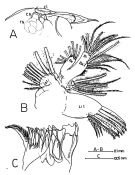 issued from : A.F. Campaner in Israel J. Zool., 1988/89, 35 (4). [p.230, Fig.1]. Female From Red Sea (G. of Elat): A, forehead and rostrum (lateral; cl = cuticular lens-shaped structure; cs = internal chiyin-like structures; rs = cluster of rounded structures); B, Mx1 (anterior; Li 1 = inner lobe 1; Le 1 = outer lobe 1; Ba2 = basipodal segment 2; R1 = endopodite; Re = exopodite)); C, Md (cutting edge). Nota: Mx1 with 13 setae on inner lobe 1 (3 on posterior surface), 2 setae on inner lobe 2 and 3 setae on inner lobe 3; 5 setae on basipodite 2; 3+4 setae on endopodite; 8 setae on exopodite; 9 on outer lobe 1.
|
 issued from : A.F. Campaner in Israel J. Zool., 1988/89, 35 (4). [p.231, Fig.2]. Female: A, Mx2 (endopodite removed; B, endopodite of Mx2; C, inner lobe 5 of Mx2 (external surface); D, row of setules on the largest seta of inner lobe 5 (external side); E, endopodite of P1; G, basipodite 1 of P2 and P3 (external margin). Nota: Mx2 with 4 setae on inner lobe 1, 3 setae each on inner lobes 2 to 4, 4 setae (2 non-sensory and 2 sensory) on inner lobe5; 8 sensory setae (3 vermiform and 5 brush-like) on endopodite; inner lobe 5 with proximally a tuft of setules on external surface. Endopodite of P1 with external flap bordered by hyaline chitinous margin; both flap and distal inner angle of endopodite bearing tuft of setules arising from posterior surface Scottocalanus securifrons: B1: tip of a sensory seta, as seen in a male; F, endopodite of P1 (external side).
|
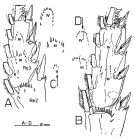 issued from : A.F. Campaner in Israel J. Zool., 1988/89, 35 (4). [p.232, Fig.3]. Female: A, part of exopodite of P2 (posterior, with groups of spines indicated by Roman numerals); B, idem for P3; C and D, corresponding groups of spines respectively on P2 and P3 of Scottocalanus securifrons.
|
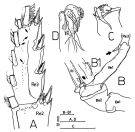 issued from : A.F. Campaner in Israel J. Zool., 1988/89, 35 (4). [p.233, Fig.4]. Male: A, part of exopodite of P4 (posterior, arrow indicates corresponding spines seen in ; B, part of male right P5; B1, hyaline flap on endopodite (another view); C, top of exopodal segment 2 of male left P5; D, idem for Scottocalanus securifrons
|
 issued from : R.B.S. Sewell in Mem. Indian Mus., 1929, X. [p.202, Fig.75]. Male (from Nankauri Harbour): P5 (right leg).
|
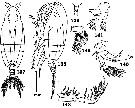 issued from : C.B. Wilson in Bull. U.S. natn Mus., 1950, 100, 14 (4). [Pl.13, Figs.137-143]. Female (from Fiji Islands): 137, habitus (dorsal); 138, idem (lateral left side); 139, rostrum; 140A2; 141, Md; 142, Mx2; 143, Mxp.
|
 issued from : C.B. Wilson in Bull. U.S. natn Mus., 1950, 100, 14 (4). [Pl.13, Figs.144-147]. Male: 144, right P5; 145, left P5; 146, endopod of left P5; 147, exopod of left P5.
|
 issued from : W. Giesbrecht in Zool. Jahrb., 1896 (1897). [Taf.5, Figs.16, 22]. As Scolecithrix chelipes. Male (from Red Sea): 16, left P5; 17, right P5; 18, exopodote 3 of right P5; 19, P1; 20, endopod of P2; 21, P3; 22, habitus (lateral).
|
 Issued from : T.C. Gopalakrishnan in Handbook Int. Zoopl. Coll., Vol. V, 1973 (IIOE). [p.189, Table]. Morphological characteristics of Macandrewella chelipes female. Compare with M. scotti, M. joanae, M. sewelli, M. asymmetrica, M. mera, M. agassizi, M. cochinensis.
|
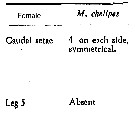 Issued from : T.C. Gopalakrishnan in Handbook Int. Zoopl. Coll., Vol. V, 1973 (IIOE). [p.186: Table]. Morphological characteristics of Macandrewella chelipes female. Compare with M. scotti, M. joanae, M. sewelli, M. asymmetrica, M. mera, M. agassizi, M. cochinensis.
|
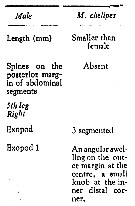 Issued from : T.C. Gopalakrishnan in Handbook Int. Zoopl. Coll., Vol. V, 1973 (IIOE). [p.186: Table]. Morphological characteristics of Macandrewella chelipes male. Compare with M. joanae, M. scotti, M. sewelli, M. asymmetrica, M. mera, M. agassizi, M. cochinensis.
|
 Issued from : T.C. Gopalakrishnan in Handbook Int. Zoopl. Coll., Vol. V, 1973 (IIOE). [p.187: Table]. Morphological characteristics of Macandrewella chelipes male. Compare with M. joanae, M. scotti, M. sewelli, M. agassizi, M. cochinensis. (not recorded: M. asymmetrica, M. mera),
|
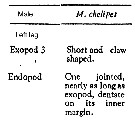 Issued from : T.C. Gopalakrishnan in Handbook Int. Zoopl. Coll., Vol. V, 1973 (IIOE). [p.188: Table]. Morphological characteristics of Macandrewella chelipes male. Compare with M. scotti, M. joanae, M. sewelli, M. agassizi, M. cochinensis. (not recorded: M. asymmetrica, M. mera),
| | | | | Ref. compl.: | | | Dorgham & al., 2012 (p.473, Table 4 as Macandrewella chelips: abundance vs season) | | | | NZ: | 2 | | |
|
Carte de distribution de Macandrewella chelipes par zones géographiques
|
| | | | | |  issued from : S. Ohtsuka, S. Nishida & K. Nakaguchi inJ. Nat. Hist., 2002, 36 [p.558, Fig.21]. issued from : S. Ohtsuka, S. Nishida & K. Nakaguchi inJ. Nat. Hist., 2002, 36 [p.558, Fig.21].
Distribution of several species of Macandrewella: 1, 2, 4, M. chelipes; 3, M. cochinensis; 4, M. scotti; 5, 8, 10, M. sewelli; 6, M. stygiana; 7, M. joanae; 8, M. asymmetrica; 8, M. mera; 9, M. agassizi; 11, M. serratipes. |
| | | | Loc: | | | Red Sea, Gulf of Aqaba, off Sharm El-Sheikh, N Indian, Nicobar Is., [No: Fiji Is., SW off Galapagos] | | | | N: | 7 | | | | Lg.: | | | (47) M: 3; (137) F: 3,5; M: 3; (863) F: 3,12-3,22; M: 3,41; {F: 3,12-3,50; M: 3,00-3,41} | | | | Rem.: | For Campaner (1989, p.233) the comparison of morphological structures between this species and Scottocalanus securifrons shows numerous common similarities. S. securifrons has the same internal features in the forehead as seen in M. chelipes, but externally its chitinous dorsal margin does not sxell markedly to form a lens-shaped structure. Appendages A1 to Mxp are structurally identical in both species. The external hyaline margin above the flap on endopodite of P1 is thicker in S. securifrons than in M. chelipes. Both species have a spine-like process on basipodite 1 of P2 to P4. The groups of spines on posterior surfaces on exopodal segments 2 and 3 of P2 and P3 are present in both species, but in S. securifrons spines of groups II to IV are more clearly arranged in an arch. Only a few spines (indicated by arrows in Fig.4A) can be seen on the posterior surface on exopodal segment 3 of P4 in S. securifrons. The structure of male P5 is basically the same in thes species, the tight leg of S. securifrons, however, has a very reduced endopodite and exopodite of 2 segments, the second of which with a hyaline flap ("conical retroverted process" in Sewell, 1929, p.202) proximally, as in M. chelipes (Fig.4B); exopodal segment 2 of left leg of S. securifrons is strongly haired distally with bent setae fewer but longer than those of M. chelipes (compare Fig.4C with Fig.4D) | | | Dernière mise à jour : 30/10/2015 | |
|
|
 Toute utilisation de ce site pour une publication sera mentionnée avec la référence suivante : Toute utilisation de ce site pour une publication sera mentionnée avec la référence suivante :
Razouls C., Desreumaux N., Kouwenberg J. et de Bovée F., 2005-2025. - Biodiversité des Copépodes planctoniques marins (morphologie, répartition géographique et données biologiques). Sorbonne Université, CNRS. Disponible sur http://copepodes.obs-banyuls.fr [Accédé le 04 décembre 2025] © copyright 2005-2025 Sorbonne Université, CNRS
|
|
 |
 |

















